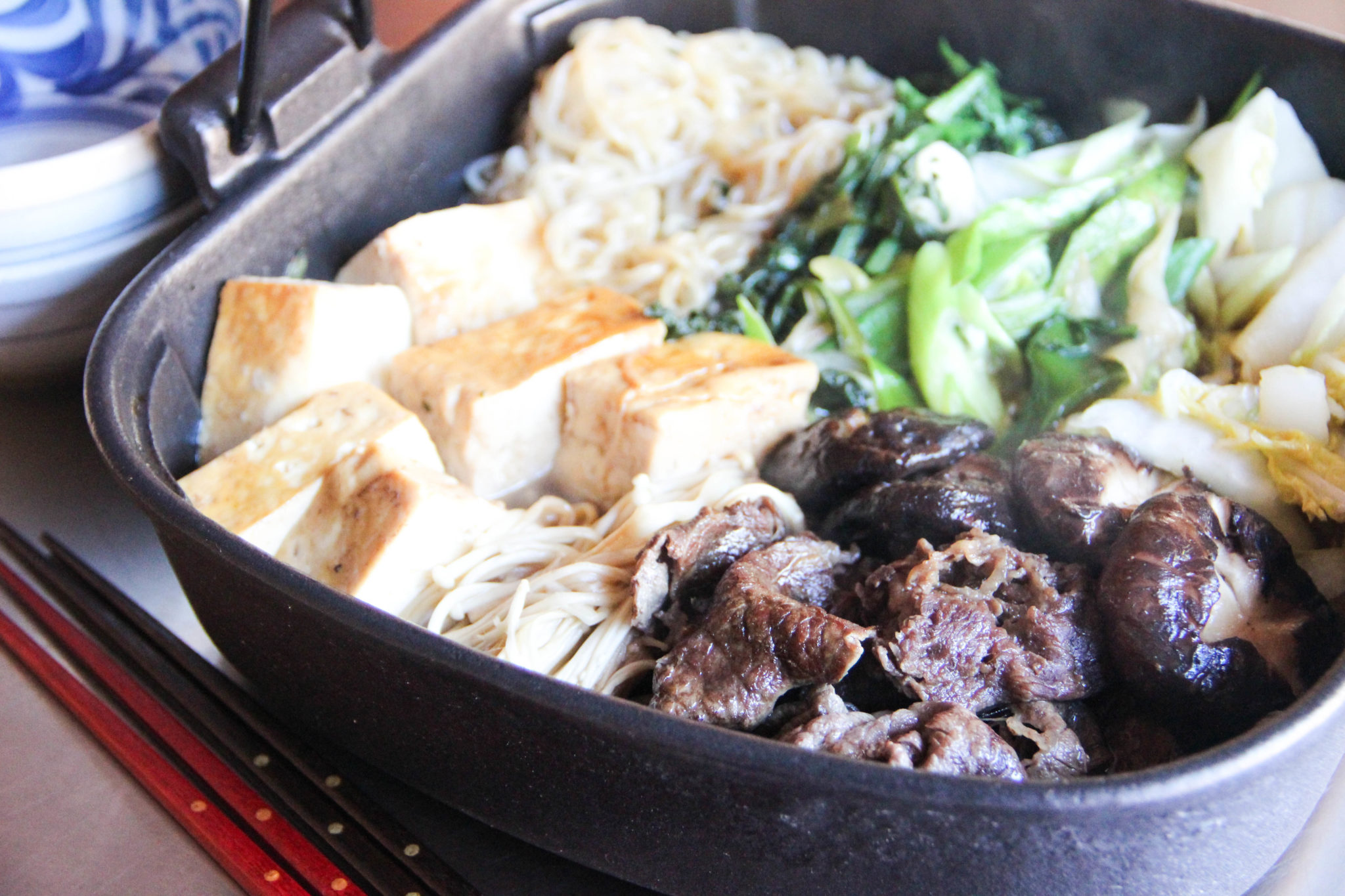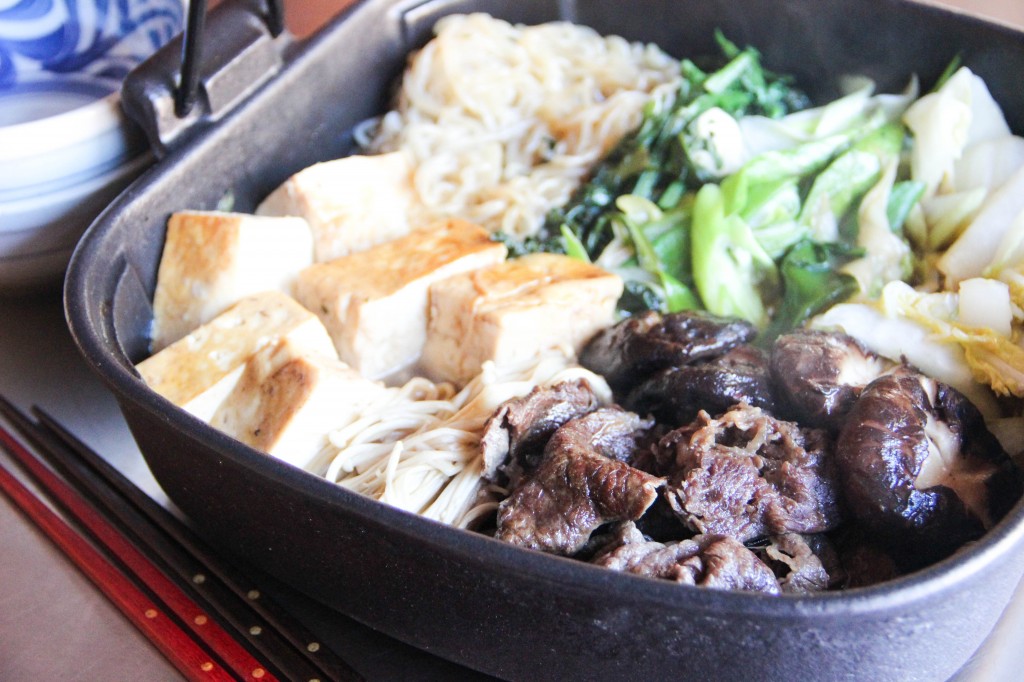Sukiyaki is one of the most popular hot pot dishes in Japan. It has a sweet and salty flavor a little bit like teriyaki sauce, but with beef and vegetable in the mix, it has its own Sukiyaki taste people love so much. We usually cook Sukiyaki in a cast iron Sukiyaki pot at the dinner table using a portable gas stove and eat it as we cook. It is a perfect dinner for family or great food to enjoy with guests.
Although Sukiyaki is a Japanese “national” food like sushi, it is different by region. In eastern Japan (Kanto), they use a premixed sauce called “Warishita” made from sugar, soy sauce, mirin, etc. to cook with meat and vegetable, but in western Japan (Kansai) we put mainly sugar and soy sauce directly onto meat in the pot to season. Because we are from the west, we make Kansai style Sukiyaki here.
In Sukiyaki, you need thinly sliced beef. Preferably with fat marbled into red meat, such as Kobe (Matsusaka) beef. They are notoriously expensive, but the texture is unbeatable compared to lean red meat. You might not even need teeth 🙂 So tender and just yummy! Here in the US, you can use thinly sliced rib-eye instead.
Other than beef, there are some ingredients you might not be familiar with:
Ito Konnyaku (Shirataki) Konnyaku is a jelly-like food made from konnyaku potatoes. Ito Konnyaku is a noodle form of Konnyaku.
Kikuna leaves Edible chrysanthemum greens which have a distinct herbal flavor.
Enoki mushrooms Long and thin white mushrooms that have a mild flavor. They are often used for different hot pot dishes in Japan.
Naganegi onions Long onions that are mostly white and thicker than green onions, but thinner than leaks.
If some of the ingredients are not available to you, you could substitute with any vegetables you like such as button mushrooms and onions.
In Japan, we dip cooked Sukiyaki beef and vegetable in raw eggs. Sounds gross? But it is not! (well, may be a little) The relatively strong Sukiyaki flavor gets mild with egg, and at the same time, the egg flavor enhances Sukiyaki taste. While it can be risky to eat raw eggs in the US, we don’t usually have problems with salmonella in eggs in Japan. (I don’t blame you if you want to skip raw eggs because you don’t want to take a chance in the US.)
If you don’t have a Sukiyaki pan nor portable gas stove, don’t worry. You can just cook in a frying pan on stove top, and take it to your dinner table like we did in our video. Either way you’ll enjoy this delicious food.

Sukiyaki Recipe
Ingredients
- 1 Tbsp oil
- 1 lb beef (thinly sliced)
- 4 Tbsp sugar
- 4 Tbsp soy sauce
- 2 Tbsp Sake
- 1/2 Nappa cabbage (cut 2″ width)
- 2 long onions (cut diagonally)
- 1 bunch Kikuna (cut 2″ long)
- 1 package tofu (cut 1″ width)
- 8 shiitake mushrooms
- 1 package enoki mushrooms
- 1 package itokonnyaku
Instructions
- Heat a pan at medium high and add oil.
- Sear beef slices in the pan, and add sugar, soy sauce, and Sake when the color of meat has started turning.
- Add the rest of the ingredients and cook about 10-15 minutes.
- Adjust seasonings if you like by adding more soy sauce and/or sugar.



35 Comments
How many people does this Sukiyaki recipe serve?
About 4, but you can add meat and veges as you have more people. It is very flexible food!
WHICH JAPANESE RESTAURANTS IN COLUMBUS OHIO SERVE sukiyaki
What if i like more soup should i make that seperately? Doesnt need to use dashi right? Thank u
Chrisine,
no dashi for Sukiyaki. You could add more sugar and soy sauce but then flavor becomes stronger…
Don’t forget the udon noodles at the end!
Tanya,
that’s true!
This was amazing!! My family and I enjoyed it completely!!! Soooo yummy!!! Though I could not find chrysanthemum leaves.
Kat,
Japanese or some Asian stores carry chrysanthemum leaves, but the best part is the beef, of course! Glad you liked it.
Hello. Any soy sauce would do? How about the kikkoman soy sauce? Would that be okay?
Anne,
yes Kikkoman soy sauce is what we use and very good.
Hey there. Can I substitute sake with mirin instead? I’ve seen some mirin brands at a Japanese food store on my way home, with price ranges that I can manage with at the time. However, it seems that they don’t offer a more affordable brand of sake at the time. And how can I adjust the flavor in case I used mirin instead?
Bernard,
you may just omit sake in Sukiyaki if you don’t want to use it.
I looked up a recipe on the computer. It was for Sukiyaki. It was a recipe from Taste of Home. People left comments saying that they liked it. Several went on to say that it was not authentic Sukiyaki, that it was more like a stir fry. This recipe sounds like a Stir Fry. It is fried, so, just curious, isn’t authentic Sukiyaki considered a stir fry? Thanks
Peggy,
Sukiyaki is not stir fry. It is kind of a hot pot dish.
I grew up in Misawa, Aomori in the north. I am curious to know what the difference the sauce ingredients may have from those shown for the west and the east of Japan. Sukiyaki is still my favorite, or one of them. 🙂
Jodi,
come and read our Sukiyaki blog and recipe!
Hi chef NORIKO I can use udon instead of itokonnyaku?I want try our recipe of sukiyaki. And yakitori.and pls teach me the Japanese word for thank you and delicious. thank u soooo much
noorul,
you can. And Japanese people actually use udon noodles for Skiyaki along with itokonnyaku.
thank you = arigatou gozaimasu
delicious = oishii (that’s what we say in the end of each video.)
Thank you so much for this recipe! I made this tonight and my family loved it! I could not find most of the vegetables you used since I live in a very rural area and not very close to stores (let alone an Asian market), so I used broccoli, snow peas, leeks, cremini mushrooms and udon noodles. Very delicious! I look forward to trying more of your recipes!
Bell,
sometimes you have to be crafty to make Japanese food outside Japan. Try our Mizutaki recipe too with your family!
is there any thing i can use to substitute for the mushrooms (i’m allergic) and still get the same flavor?
Daniel,
just leave it out.
I would like to know whether Sukiyaki can be prepared leaving out the tofu or tofu is one of the ingredients that should not be left out.
Monica,
if you don’t like it, leave it out.
Hi! I’m a big fan of the food you make and tried most of these recipes. I live in Hawaii and the way they make sukiyaki (nabe) is to boil the shouyu and sugar then cook the meat and add vegetables. Is this a different food or just a different way to cook?
Syti,
Sukiyaki can be made in different ways by regions in Japan. We have a little story with the recipe on our web site.
heya, i made this for my family and a friend last night and it was so tasty! It’s definitely a family favourite and i will be making it again. I had to change some ingredients and japanese vegetables aren’t common in Yorkshire (north england) and i also added a small amount of beef stock because my children love broth with it. I used the leftover broth to make a risotto that my children had for lunch today too.
thankyou! ^_^
Kitty,
Sukiyaki in Yorkshire! Glad you liked our recipe!
This is the same exact way I was taught to make this from my mom, she was taught by my O bachan. She is from Osaka
Noriko, I was born in Tachikawa and grew up eating sukiyaki. My mom had a rice kettle with a concave lip. The lid set inside that lip and as the rice cooked, the lid would bounce a little. When the sound of the bounce stopped, the rice was done. My mom’s kettle broke some years back and I have been looking for a replacement. Do you know this type of kettle and where I can get one?
Thank you very much for this delicious recipe. Just what I needed! My wife used to cook so much, but we are separated now, and I realize that I didn’t learn how to cook all those Japanese flavors! My kids want them, I want them, and you’re recipe made us so happy tonight! Thank you thank you thank you!!!! Domo arigato gozaimashita!!!
this is great. i’ve been looking for a way to introduce some of my friends to this wonderful style of cooking. i must say that i was quite surprise by japanese potatoes. i’ve been sending away for potatoes from peru, but when i got to try a nice fresh potato from japan it was delicious. also, i agree with tanya – don’t forget the udon! sometimes just udon and dashi is all i need. well, maybe a little chopped scallion (naganegi) and maybe a little… oh well, you get the idea ((-;